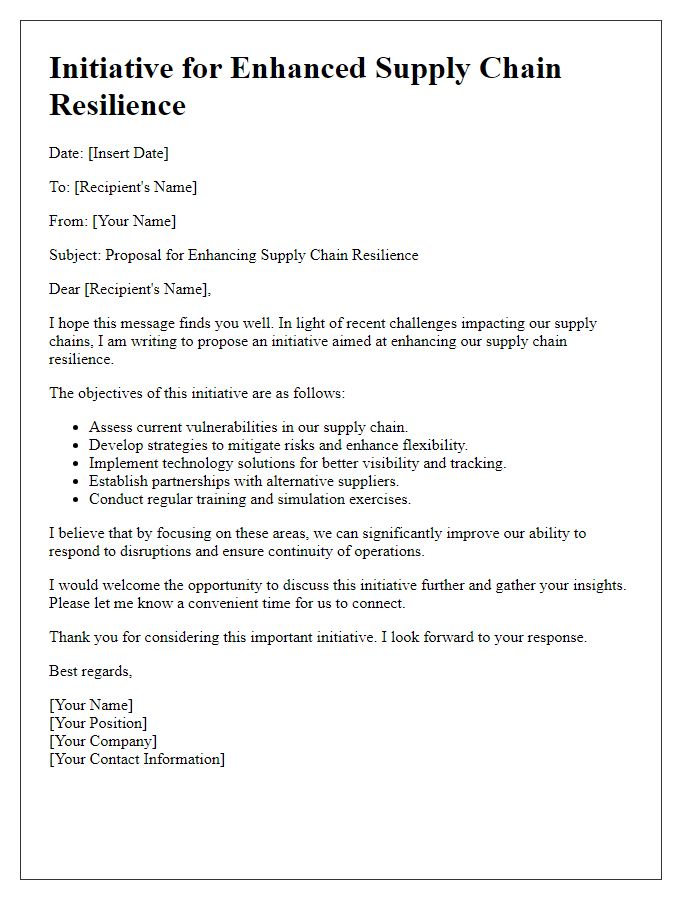Supply chain diversification is a crucial strategy for businesses looking to enhance resilience and adaptability in an ever-evolving market. By exploring various sourcing options and fostering strong relationships with multiple suppliers, companies can mitigate risks and ensure a steady flow of goods and services. This approach not only bolsters operational efficiency but also opens doors to new opportunities for innovation and growth. Curious to learn more about crafting an effective supply chain diversification plan?

Objective and Goals
A supply chain diversification plan aims to enhance resilience and efficiency by incorporating alternative suppliers and logistics channels. The primary objective involves reducing dependency on a single supplier base, mitigating risks associated with disruptions such as natural disasters or geopolitical tensions. Goals include identifying at least three alternative suppliers per key component by Q2 2024, optimizing inventory management techniques to maintain adequate stock levels while minimizing holding costs, and implementing a robust risk assessment framework to evaluate supplier stability. The plan seeks to improve responsiveness to market changes, foster innovation through collaboration with diverse suppliers, and increase overall cost-effectiveness across the supply chain operations.
Risk Assessment
Supply chain diversification plans require thorough risk assessments to identify vulnerabilities and opportunities. Current global supply chains face challenges such as geopolitical tensions (examples include the US-China trade war), natural disasters (such as hurricanes disrupting shipments), and pandemics (like COVID-19 leading to factory closures). Factors influencing risk include supplier location (Asia, Europe, North America), dependency on single-source suppliers, and transportation routes (shipping lanes through the Suez Canal). Assessment tools such as SWOT analysis (Strengths, Weaknesses, Opportunities, Threats) can provide insight into potential disruptions. Implementing strategies like multi-sourcing, local sourcing, and inventory buffers can mitigate risks and enhance resilience. Understanding these elements ensures a robust supply chain capable of adapting to ever-changing market conditions.
Supplier Evaluation Criteria
Supplier evaluation criteria play a crucial role in supply chain diversification strategies. Key factors include pricing structures, which must be competitive to maintain profitability while ensuring quality standards are met. Delivery performance is critical, with metrics such as on-time delivery rates (ideally above 95%) and lead times (around 1-2 weeks for non-custom items) providing insights into a supplier's reliability. Financial stability is assessed through metrics like credit ratings and revenue trends, ensuring the supplier's longevity and capacity to fulfill orders. Quality assurance processes, such as ISO 9001 certifications, indicate adherence to international standards, while geographical location influences risks related to logistics and international regulations. Effective communication and responsiveness during both regular operations and crisis situations can significantly impact supplier relationships, ensuring a smooth supply chain operation in volatile markets. Overall, a comprehensive evaluation utilizing these criteria ensures a robust and resilient supply chain capable of adapting to market dynamics.
Implementation Timeline
Supply chain diversification requires a strategic implementation timeline to ensure efficiency and effectiveness. Initial assessment phase involves a 4-week review of current supplier contracts and inventory levels, targeted for January 2024. The next stage encompasses a 6-week market analysis from February to March 2024, focusing on potential new suppliers located across Europe and Asia to mitigate geopolitical risks. Supplier selection criteria will be finalized in April 2024, which includes sustainability practices and cost-effectiveness. Following this, pilot partnerships with selected suppliers will commence in May 2024 and run for 3 months to evaluate performance metrics such as delivery timelines and quality standards. Full-scale integration of diverse suppliers is slated for August 2024, with ongoing monitoring established through quarterly reviews to identify opportunities for further optimization and risk management across the supply chain.
Performance Metrics and Monitoring
Performance metrics provide essential data for evaluating the effectiveness of supply chain diversification strategies. Key performance indicators (KPIs) track various aspects, including supplier reliability, lead times, and cost efficiency. For example, measuring on-time delivery rates reveals suppliers' punctuality and reliability in meeting order schedules, crucial for maintaining production schedules. Cost per unit across different suppliers highlights cost-effective sourcing options, ensuring budget adherence and profitability. Additionally, monitoring inventory turnover rates helps assess how quickly stock moves through the supply chain, allowing for adjustments to minimize excess inventory. Implementing robust monitoring systems, such as real-time dashboards, ensures ongoing assessment of these metrics, facilitating timely decision-making and strategic adjustments in response to supply chain dynamics. Regular reviews, at least quarterly, ensure continued alignment with business goals and adaptability to market conditions.
Letter Template For Supply Chain Diversification Plan Samples
Letter template of a stakeholder engagement plan for supply chain diversification.

Letter template of a project report on supply chain diversification efforts.

Letter template of an action plan for supply chain supplier diversification.

Letter template of a partner collaboration agreement for supply chain diversity.

Letter template of a budget proposal for supply chain diversification activities.









Comments